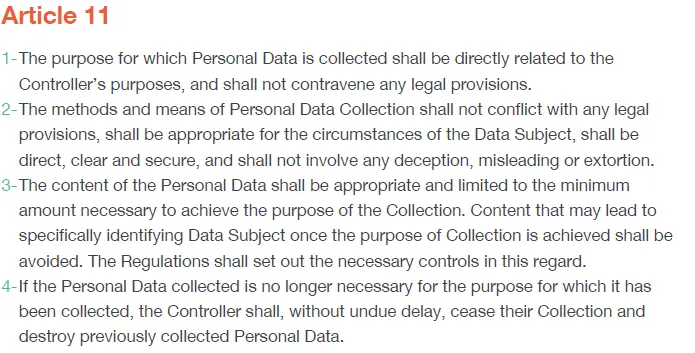
Explanation KSA PDPL – Article 11
This KSA PDPL – Article 11 ensures that the collection and use of personal data are strictly related to the purpose for which the data is gathered. It emphasizes lawful methods, limits the amount of data collected to what is necessary, and mandates the destruction of data once it’s no longer required.
If you rely on consent as a lawful basis for processing of sensitive data, such consent must be
explicit (as per Art. 11 of the Implementing Regulation to the PDPL).
Key Points
- Purpose Alignment: Personal data must be collected for purposes that directly align with the Controller’s legitimate objectives and comply with the law.
- Lawful Methods: Collection methods must be clear, lawful, direct, and secure. Deception, misleading tactics, or extortion are prohibited.
- Data Minimization: Only collect the minimal amount of data necessary for the specific purpose. Avoid collecting data that could specifically identify a person unless absolutely required.
- Data Deletion: When the collected personal data is no longer necessary for the original purpose, the Controller must stop collecting it and destroy the data without undue delay.
General Activation Steps KSA PDPL – Article 11
- Define Purpose: Clearly outline the purpose for collecting personal data in alignment with business and legal needs.
- Choose Lawful Collection Methods: Ensure the means of data collection are appropriate, transparent, secure, and comply with legal provisions.
- Implement Data Minimization: Review the data being collected to ensure it is limited to what is essential for the defined purpose.
- Monitor Data Usage: Regularly assess whether collected data is still necessary. When the data has served its purpose, take immediate steps to securely destroy it.
- Establish Controls: Set up procedures and controls for ongoing monitoring and review of data collection practices to ensure compliance with the article.
Use Cases KSA PDPL – Article 11
- E-commerce: An online store collects customer data for order fulfillment. The store ensures the data is only used for this purpose, and unnecessary or expired customer information is securely deleted after the order is completed.
- Healthcare: A hospital collects patient data for treatment. Once treatment is completed, and the data is no longer necessary for ongoing care, the hospital must delete it to comply with privacy laws.
Dependencies
- Legal Compliance: Controllers need to ensure alignment with KSA PDPL and other necessary data protection laws.
- Data Governance Framework: Strong data governance policies must be in place to manage the collection, retention, and deletion of personal data.
- Security Practices: Secure methods for data collection, storage, and destruction are crucial for compliance.
Tools and Technologies KSA PDPL – Article 11
- Data Discovery Tools: These are used to identify personal data across systems (e.g., OneTrust, Varonis).
- Data Minimization Solutions: Implement software to ensure data collection practices align with purpose limitations (e.g., TrustArc, BigID).
- Encryption and Secure Deletion Tools: Use tools for securely storing and deleting data (e.g., VeraCrypt, Blancco).
- Audit and Monitoring Systems: Deploy continuous monitoring to ensure data collection and retention are compliant (e.g., AuditBoard, Splunk).
For Your Further Reading:
- Data Strategy vs. Data Platform Strategy
- KSA PDPL (Personal Data Protection Law) – Initial Framework
- KSA PDPL – Consent Not Mandatory
- KSA PDPL – Article 5, Article 6, Article 7, Article 8, Article 9, & Article 10
- KSA NDMO – Data Catalog and Metadata
- KSA NDMO – Personal Data Protection – Initial Assessment
- KSA NDMO – DG Artifacts Control – Data Management Issue Tracking Register
- KSA NDMO – Personal Data Protection – PDP Plan, & PDP Training, Data Breach Notification
- KSA NDMO – Classification Process, & Data Breach Management
- Enterprise Architecture Governance & TOGAF – Components
- Enterprise Architecture & Architecture Framework
- TOGAF – ADM (Architecture Development Method) vs. Enterprise Continuum
- TOGAF – Architecture Content Framework
- TOGAF – ADM Features & Phases
- Data Security Standards
- Data Steward – Stewardship Activities
- Data Modeling – Metrics and Checklist
- How to Measure the Value of Data
- What is Content and Content Management?

